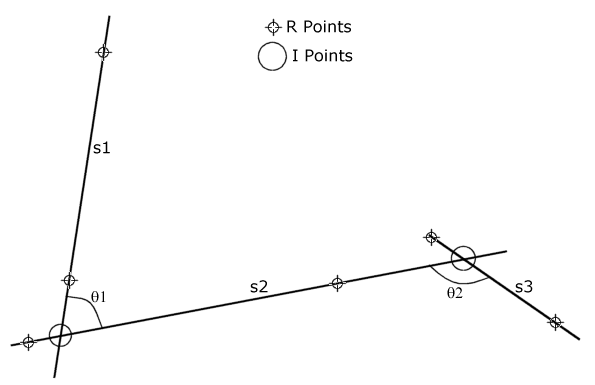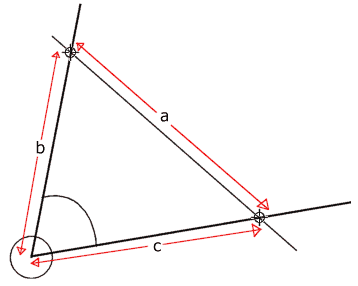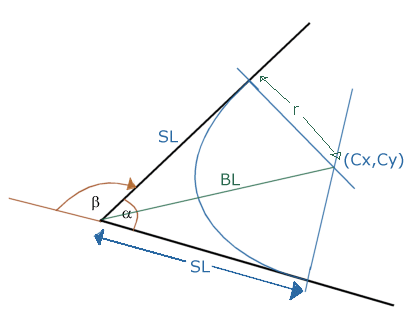Creating a TRK Pt I by P.A.Flack 1999
Hopefully, if you follow the instructions on this
page, you will be able to create a new .trk file for the track of your
choice. The method described is not the only way to get the required
numbers, but in my opinion it is the most accurate, and will result in
the start and end points matching up every time (good news). For
the trk I used this method for, the start and end points were within 0.0001metres
- not too bad...
Some points to consider:
-
Do not make a complex track before you've done a simple one - i.e. go for
Avus instead of Clermont-Ferrand...
-
This page doesn't detail how to create non-constant-radius corners.
They require different centre points and I haven't worked out a mathematical
method for them yet. Try to keep the corners as single sections with
a straight before and after - it's a heck of a lot easier to deal with.
The straights can be very short if necessary.
Stage I
Get a rough plan of the track drawn out with as many measurements as
you can do on it. Typically, you'll need:
-
A bunch of lines, one per straight, intersecting each other (see first
diagram).
-
Lengths of the straights (roughly, so you can draw the first diagram)
-
Corner angles (where known - you'll be calculating them anyway)
-
Corner radii (where known - you can make them up later)

This diagram shows 3 straights. The only coordinates you should
know, are two (x,y) pairs for each straight (R points). These are
the points that will be used to calculate everything else, and the precision
of these is not too important. It is probably easier to measure them
to the closest metre, for example.
First calculations: The I points (intersections of each
pair of straights). Since you know the equations of the straights
(from the two points per straight), the I points can be found. Here's
some code that'll do the job: You may as well use the final case
for all the calculations you do by 'hand'.
int calcintersection(double& ix, double& iy, double ax1,
double ay1, double ax2, double ay2, double bx1, double by1, double bx2,
double by2) {
//* calculates the intersection of two lines
//* all values are doubles to increase the accuracy
//* parallel lines will fail (-1) (ix=0, iy=0)
//* single points will fail (-2) (ix=0, iy=0)
//* success returns 0
double adx=ax2-ax1, ady=ay2-ay1;
double bdx=bx2-bx1, bdy=by2-by1;
if (adx==0 && ady==0) { ix=0; iy=0; return
-2; } //can't do
if (bdx==0 && bdy==0) { ix=0; iy=0; return
-2; } //can't do
if (ady!=0 && bdy!=0) {
if (adx/ady==bdx/bdy)
{ ix=0; iy=0; return -1; } //can't do
}
if (adx!=0 &&
bdx!=0) {
if (ady/adx==bdy/bdx)
{ ix=0; iy=0; return -1; } //can't do
}
if (adx==0 && ady!=0 && bdx!=0 &&
bdy==0) {
//a is vertical and
b is horizontal
ix=ax1; iy=by1;
return 1;
}
if (ady==0 && adx!=0 && bdy!=0 &&
bdx==0) {
//b is vertical and
a is horizontal
ix=bx1; iy=ay1;
return 1;
}
if (ady==0 && adx!=0) {
//a is horizontal and
b is at an angle
iy=ay1;
ix=((iy-by1)*(bx2-bx1)/(by2-by1))+bx1;
return 1;
}
if (adx==0 && ady!=0) {
//a is vertical and
b is at an angle
ix=ax1;
iy=((ix-bx1)*(by2-by1)/(bx2-bx1))+by1;
return 1;
}
if (bdy==0 && bdx!=0) {
//b is horizontal and
a is at an angle
iy=by1;
ix=((iy-ay1)*(ax2-ax1)/(ay2-ay1))+ax1;
return 1;
}
if (bdx==0 && bdy!=0) {
//b is vertical and
a is at an angle
ix=bx1;
iy=((ix-ax1)*(ay2-ay1)/(ax2-ax1))+ay1;
return 1;
}
//otherwise all other combinations must be two lines
at angles, not parallel, nor single points. this should work since
the cases where ady=0 or bdy=0 have been dealt with and so has (adx/ady
- bdx/bdy)=0 (parallel lines)
iy=(bx1-ax1+(ay1*adx/ady)-(by1*bdx/bdy))/((adx/ady)-(bdx/bdy));
ix=((iy-ay1)*adx/ady)+ax1;
return 1;
}
So now you know the lengths between the I & R points ( L = sqrt(
((x2-x1)*(x2-x1)) + ((y2-y1)*(y2-y1)) )
The angles inside the corners can also be found using the wonderful
cosine rule:
angle = acos ( (a^2 - b^2 - c^2) / (-2 * b * c) )
( or: cos angle = ((a^2 - b^2 - c^2) / (-2 * b * c))
)
where a,b&c are the lengths. It doesn't matter how long each
is, so using the I point & the two inner R points is the best idea.

So now you know the angle of the corner. The next stage is...
Stage II
Decide on the radius of each corner. This might be anything from
5 metres to 500 metres, depending on the sweepyness (made that word up)
of the corner. E.g. La Source would be small radius, Curva Grande
medium, and that bit between the 2nd and 3rd corners at Silverstone high
(didn't know that bit was curved? he he). See the diagram below:

Right then. (Cx,Cy) is our goal here, the centre of the corner.
Also, SL is a useful value, because it lets you work out the length of
the straights (another goal).
SL = r / tan (0.5*alpha), r = radius of corner
BL = r / sin (0.5*alpha)
Then, using the I point, BL, and alpha in relation to the angle of one
of the segments (carry a starting known value right around the track),
(Cx, Cy) can be found using simple trig.: Cx =
Ix + cos (a) *BL, Cy = Iy + sin (a) * BL.
[Hang about, shouldn't we be using a/2 ? mmm...]
Beta = 180 - alpha. Beta is the curvature value needed for each
corner.
The length of the corner, as the car travels is: (theta*pi*radius)/180,
where theta is the angle opposite alpha, theta=180-alpha.
Phew!
All of that should give you a big bunch of numbers on your nice pretty
hand-drawn plan of the track you're creating. For each straight section,
you should have:
-
(Sx,Sy)
-
Heading
-
Length (not including the SL lengths at each end)
-
(Ex,Ey)
For each curve section you should have:
-
(Cx,Cy)
-
(Sx,Sy) & StartAngle (angle from centre point to start point)
-
(Ex,Ey) & EndAngle
-
Radius
-
Track Length (circumference of the arc between StartAngle & EndAngle)
-
BL & SL for any later calculations/adjustments
-
Curvature (Beta - negative for right hand turns, positive for left hand
turns)
Next time I get around to writing something, I'll detail how to make the
walls for the .TRK, i.e. the barriers, and different surfaces. Just
look back at the detail above and remember that all that was just to get
a centre line. Eek!


